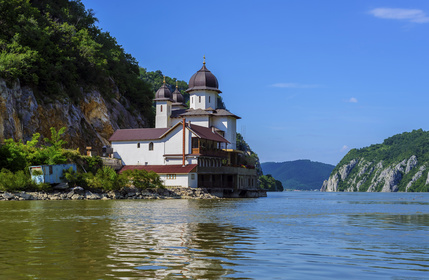- Home/
- In Focus/
- Tourism - how to present the beauty of our common home?
Tourism - how to present the beauty of our common home?
Winner of the Round 3, Voice of the Region Competition
“Danubik” on a voyage to the heart of darkness,
Essay by Antoaneta Naydenova, 34 years, Vidin
Beauty is in the eyes of the beholder. The region of Southeastern Europe (SEE), geographically mapped around the Balkan mountains, boasts an unique experience deriving from the inextricably mingled tapestry of culture, historical circumstances, natural beauty and, of course, the idiosyncratic Balkan mentality. This mentality born out of the perpetual clashes during different historical times (mostly known as the clashes “them-us”) resulted in the cultivation of certain traits of character among Balkan peoples - ingenuity, hospitality, perseverance, tenacity, strength. The uniqueness of the region comes from the multifaceted experience it offers, the national-psychology of the people who inhabit it, and is perhaps the most intriguing aspect to a foreign tourist. The common aim of the people from the region is for this complexity to finally be justly assessed and positioned as it deserves in the multicultural Europe. To sum it all up - part of the region’s charm should focus on history, culture and national-psychology.
All countries from the region have unequivocally declared their intention to become members of the European and Euro-Atlantic structures. The reform processes within the societies in SEE countries have gradually managed to distract their attention from the old time rivalries and brought a new spirit of belonging and cooperation. However, when it comes to bringing this new spirit to a higher level – a joint project for instance, things become more challenging. In the last few years, particularly in the tourism sector we witness appearance of sporadic tourist locations that do not change the big picture radically. Albania has largely grabbed the attention and has managed to bring many tourists to its coastline, rising as a promising tourist location. Bosnia and Herzegovina has also demonstrated its potential as an adventure tourism destination. Montenegro is also continuing to attract tourists’ attention via offers for mountain + sea tourism packages within one hour distance. Bulgaria is appearing on the tourist map as a destination for spa, camping and sports. When it comes to presenting “our common home”, however, countries encounter many obstacles. Let us list a few of them:
Physical connectivity within the SEE but also between the region and the rest of the world remains a big hurdle. In the absence of a regional airline a joint tourist product involving few countries is not competitive considering this costly and time-consuming service. Despite strong public diplomacy aimed at mobilizing resources for road infrastructure along Pan European Corridors (8,10,4,7) results have not yet become promising. Investment into the railway infrastructure is also poor, although railway tourist arrangements have the potential to encompass the whole scenic beauty of destinations like Montenegro and Bosnia and Herzegovina. According to a recent article in the “Guardian”, comparing destinations in SEE to those in Western Europe that can be reached within 22 hours via railway the results are striking.[i] The lack of proper physical connectivity strongly undermines our potential to develop sustainable tourism that could generate significant national revenue.
Furthermore, in order to present the beauty of our common home via a joint tourist product we need also to invest in the infrastructure around the landmark tourist locations within the countries. Most of these locations look like sporadic beautiful islands starkly contrasted by the surrounding environment. Lack of adequate hotel capacity is also evident. Creating a joint tourist product would also most probably require the establishment of new border crossing points between the countries concerned.
A joint tourist product would be successful if it targeted appropriate audiences. The processes of European and Euro-Atlantic integration of the countries of SEE have largely set out the framework of cooperation. Trade agreements and visa liberalization have undoubtedly set the direction for cooperation. However, diversifying the targeted audience with old time friends should also not be forgotten. South East Asia, Africa, Arab countries could be brought on board as potential tourist customers via active tourist campaigns in the region including tourist fairs, meetings between tourist agencies, media campaign, etc.
Concerning the joint tourist product of the Balkan countries, the first thing that comes to my mind is the river Danube, an everlasting symbol of the continent. The second longest river in Europe has often been branded as an attractive tourist destination. Still, the Danube has not been properly recognized. As a native of Vidin, a Bulgarian town situated along Danube, the river has always been associated with biodiversity, sports events, camping, medieval celebrations along fortress Baba Vida, spring-bridge events, and fisherman’s dream. However, Vidin remains the poorest region in the country, which leads to conclusion that the Danube’s potential has been far from fully exhausted. Ironically the river starts in Schwartzwald in Germany but if we follow its stream it appears that it descends into the heart of darkness much further downstream. In a unique way, for the curious historians and for the political connoisseurs the different locations on the river also present an opportunity to comprehend how the political landscape of Europe evolved over the time - the transition of SEE countries to democracy, wars in former Yugoslavia, conflict in Ukraine. A cruise along the river could provide a different perspective of looking at Europe, a more interesting one for tourists from other continents. For instance, we could build a ship called “Danubik” in the Danube macro-region. Headlines alike “Danubik” on a voyage to the heart of darkness could generate interest of tourist from other continents!* This designation is without prejudice to positions on status, and is in line with UNSCR 1244 and the ICJ Opinion on the Kosovo declaration of independence

